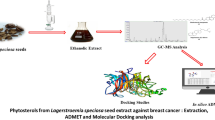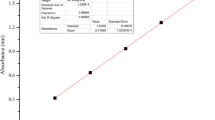Abstract
Breast and prostate cancers are the first and second most leading cause of mortality and morbidity in women and men respectively. Today lots of drugs are available for treatment but their adverse effect, potentially distressing toxicity only add to patient discomfort and limits their use. Identification of novel sources for developing new anticancer drugs with little or no side effect is imperative. In vitro antioxidant activities crude and degummed Moringa oleifera seed oil were determined using standard methods. Fatty acid and phytosterols were identified through GC–MS. Molecular docking studies was performed to investigate the binding interactions between natural compounds and five various anti-cancer drug targets. Also the proteins were docked to standard inhibitors and the binding affinities were determined. Molecular interactions between proteins and ligands were viewed with discovery studio 4.5. The binding energy was compared with the known inflammatory, breast and prostate cancer inhibitory drugs namely: exemestane, talazoparib, pictilisib, thalidomide and Z-IETD-fmk. Crude oil exhibited more potent antioxidant activities than the degummed oil. Minerals and vitamins were reduced after degumming. Phytosterol showed that β-Sitosterol is the predominant phytosterol which was higher in the degummed oil. β-Sitosterol displayed the best inhibitory activity against the standard inhibitors except Z-IETD-fmk; while oleic acid exhibited poor binding energy when compared with the standard inhibitors except thalidomide. β-Sitosterol played a promising role against breast and prostate cancer protein targets and hence can act as a template for further studies as cancer drug candidates.
















Similar content being viewed by others
Data availability
The datasets supporting the conclusions of this article are included within the article.
References
Afsar T, Razak S, Khan MR, Mawash S, Almajwal A, Shabir M, Haq IU (2016) Evaluation of antioxidant, anti-hemolytic and anticancer activity of various solvent extracts of Acacia hydaspica R. Parker aerial parts. BMC Complem Altern Med 16(1):258
Aiyegoro OA, Okoh AI (2010) Preliminary phytochemical screening and in vitro antioxidant activities of the aqueous extract of Helichrysum longifolium DC. BMC Complem Altern Med 10:21–27
Alam MN, Bristi NJ, Rafiquzzaman M (2013) Review on in vivo and in vitro methods evaluation of antioxidant activity. Saudi Pharm J 21:143–152
Ansari N, Khodagholi F (2013) Natural products as promising drug candidates for the treatment of Alzheimer’s disease: molecular mechanism aspect. Curr Neuropharmacol 11(4):414–429
Anwar F, Latif SFM, Ashraf MFA, Gilani AH (2007) Moringaoleifera: a food plant with multiple medicinal uses. Phytother Res 2:17–25
Association of Vitamin Chemists, Methods of vitamin assay (1966) Prepared by the Association of Vitamin Chemists, inc. Myer Freed, chairman, Methods Committee. Interscience Publishers, New York, pp 7–18
Barakat H, Ghazal GA (2016) Physicochemical properties of Moringa oleifera seeds and their edible oil cultivated at different regions in Egypt. Food Nutr Sci 7:472–484
Chumark P, Khunawat P, Sanvarinda Y, Phornchirasilp S, Morales NP, Phivthong-ngam L, Ratanachamnong P, Srisawat S, Pongrapeeporn K (2008) The in Vitro and ex Vivo antioxidant properties, hypolipidaemic and antiatherosclerotic activities of water extract of Moringa oleifera Lam. leaves. J Ethnopharmacol 116:439–446
Cuzick J (2008) Hormone replacement therapy and the risk of breast cancer. Eur J Cancer 44:2344–2349
Ekpete OA, Edori OS, Fubara EP (2013) Proximate and mineral composition of some Nigerian fruits. Br J Appl Sci Technol 3:1447–1454
Ghosh A (2003) Herbal folk remedies of Bankura and Medinipur districts, West Bengal (India). Indian J Tradit Knowl 2:393–396
Khalafalla MM, Abdellatef E, Dafalla HM, Nassrallah A, Aboul-Enein A, Lightfoot DA (2010) Active principle from Moringa oleifera lam leaves effective against two leukemias and a hepatocarcinoma. Afr J Biotech 9:8467–8471
Kirk RS, Sawyer R (1991) Pearson’s composition and analysis of foods, 9th edn. Longman Science Technology, London, pp 607–617
Lalas S, Tsaknis J (2002) Characterization of Moringa oleifera seed oil variety “periyakulam 1”. J Food Compos Anal 15:65–77
Lipinski CA, Lombardo F, Dominy BW, Feeney PJ (2001) Experimental and computational approaches to estimate solubility and permeability in drug discovery and development settings”. Adv Drug Deliv Rev 46(1–3):3–26
Miyoshi N, Takabayashi S, Osawa T, Nakamura Y (2004) Benzyl isothiocyanate inhibits excessive superoxide generation in inflammatory leukocytes: implication for prevention against inflammation-related carcinogenesis. Carcinogenesis 25:567–575
O’Boyle NM, Banck M, James CA, Morley C, Vandermeersch T, Hutchison GR (2011) Open Babel: an open chemical toolbox. J Cheminform 3:33–37
Ogunsina BS, Indira TN, Bhatnagar AS, Radha C, Debnath S, Gopala KAG (2014) Quality characteristics and stability of Moringa oleifera seed oil of Indian origin. J Food Sci Technol 51(3):503–510
Ferlay J, Colombet M, Soerjomataram I, Mathers C, Parkin DM, Piñeros M, Znaor A, Bray F (2019) Estimating the global cancer incidence and mortality in 2018: GLOBOCAN sources and methods. Int J Cancer 144(8):1941–1953
Prins GS (2008) Endocrine disruptors and prostate cancer risk. Endocr Relat Cancer 15:649–656
Saa RW, Fombang EN, Ndjantou EB, Njintang NY (2019) Treatments and uses of Moringa oleifera seeds in human nutrition: a review. Food Sci Nutr 7:1911–1919
Saini RK, Shetty NP, Prakash M, Giridhar P (2014) Effect of dehydration methods on retention of carotenoids, tocopherols, ascorbic acid and antioxidant activity in Moringa oleifera leaves and preparation of a RTE product. J Food Sci Technol 51:2176–2182
Sánchez-Machado DI, López-Cervantes J, Núñez-Gastélum JA, Servín de la Mora-López G, López-Hernández J, Paseiro-Losada P (2015) Effect of the refining process on Moringa oleifera seed oil quality. Food Chem 187:53–57
Subbroto KS, Soo BL, Jihye W, Hye YC, Kyeongseok KG, Ahmed AD, Ssang-goo C (2017) Correlation between oxidative stress, nutrition, and cancer initiation. Int J Mol Sci 18(7):1544–1549
Tollenaere JP (1996) The role of structure-based ligand design and molecular modelling in drug discovery. Pharm World Sci 18(2):56–62
Trott O, Olson AJ (2010) AutoDock Vina: improving the speed and accuracy of docking with a new scoring function, efficient optimization, and multithreading. J Comput Chem 31:455–461
Tsaknis J (1998) Characterization of Moringa peregrine Arabian seed oil. GrasesAceities (SeVilla) 49(2):170–176
Tsaknis J, Lalas S, Gergis V, Dourtoglou V, Spilitois V (1999) Characterization of Moringa oleifera variety Mbololo seed oil of Kenya. J Agric Food Chem 47:4495–4499
Veber DF, Johnson SR, Cheng HY, Smith BR, Ward KW, Kopple KD (2002) Molecular properties that influence the oral bioavailability of drug candidates. J Med Chem 45(12):2615–2623
Acknowledgement
Authors express their appreciation to the staff and members of Central Research Laboratories Illorin for providing us with facilities for this study.
Funding
There was no external or internal grant for this study.
Author information
Authors and Affiliations
Contributions
VOA and EA performed the experiment, VOA and EA designed the experiment and wrote the manuscript, OO and FIC performed the GC–MS part, FN helped in the interpretation of the results, UR provided the seed from their farm. All the authors read the manuscript and have approved the final version of the manuscript.
Corresponding author
Ethics declarations
Ethical statement
The manuscript does not contain any data regarding human or animal objects so no need of approval from ethical committee and consent from participants.
Conflict interest
Victor O. Apeh has no conflict of interest. Emeka Asogwa has no conflict of interest. Felicia I. Chukwuma has no conflict of interest. Obiora F. Okonkwo has no conflict of interest. Florence Nwora has no conflict of interest. Uke Rosemary has no conflict of interest.
Additional information
Publisher's Note
Springer Nature remains neutral with regard to jurisdictional claims in published maps and institutional affiliations.
Rights and permissions
About this article
Cite this article
Apeh, V.O., Asogwa, E., Chukwuma, F.I. et al. Chemical analysis and in silico anticancer and anti-inflammatory potentials of bioactive compounds from Moringaoleifera seed oil. ADV TRADIT MED (ADTM) 22, 59–74 (2022). https://doi.org/10.1007/s13596-020-00521-y
Received:
Accepted:
Published:
Issue Date:
DOI: https://doi.org/10.1007/s13596-020-00521-y




